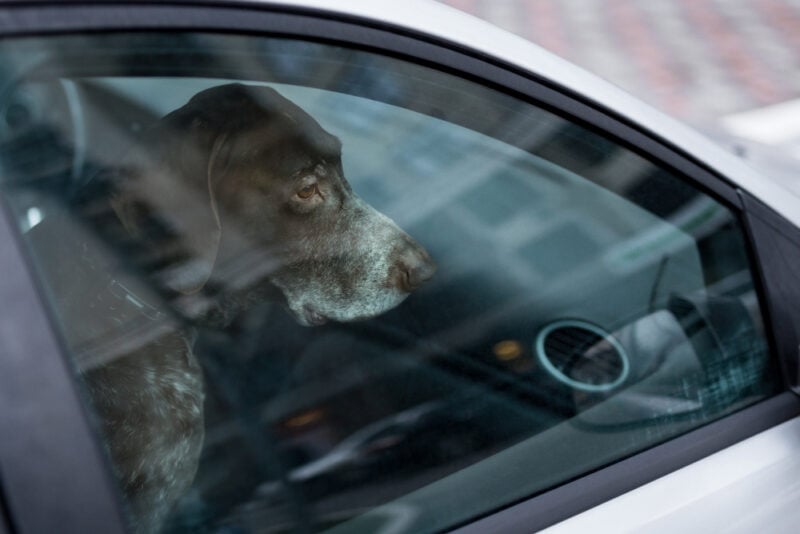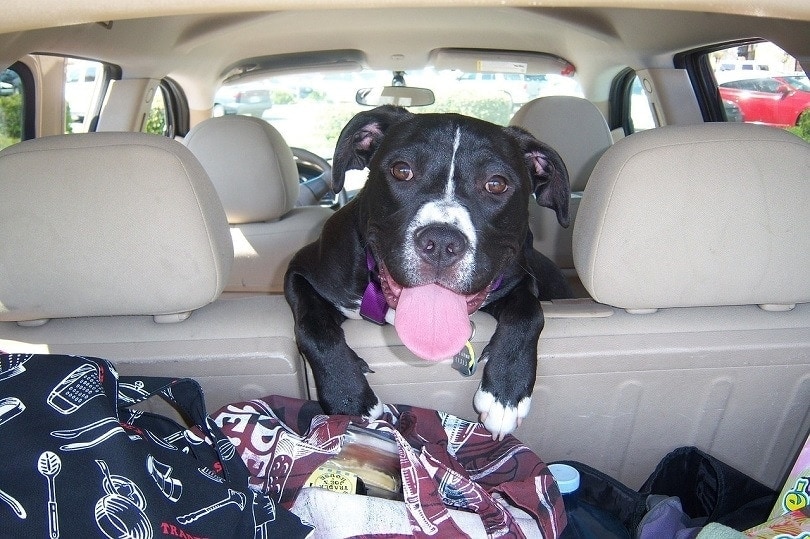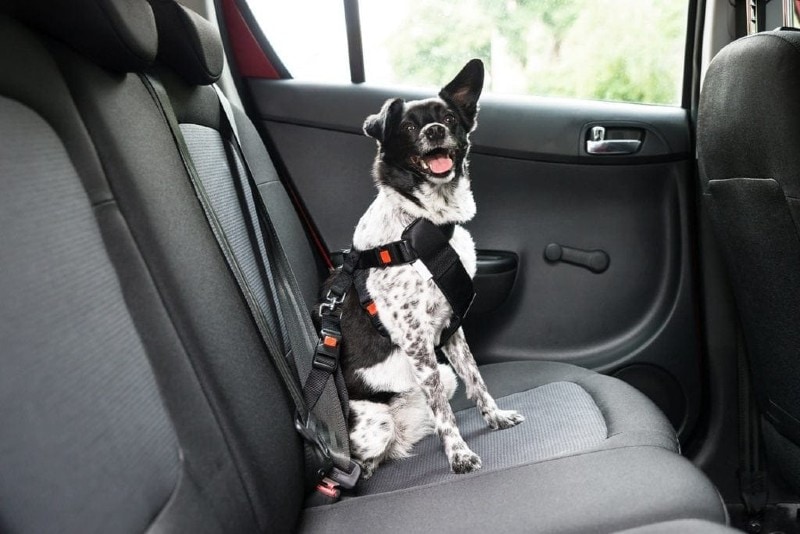Click to Skip Ahead
If it is really hot outside, most pet parents correctly assume it is too hot for their pets in the car. However, temperatures can quickly become dangerous1 in a car at as low as 60°F. It does not have to be hot outside to get hot inside a closed car. In direct sunlight, a car can reach 100°F within 20 minutes at 70ºF outside temperature.
You don’t have to leave your dog inside the car for long. The temperature can spike to dangerous levels in ten minutes on a 60°F day. On hotter days, the temperature can reach dangerous levels in only a few minutes. Therefore, not even a quick run into the store is safe.
Heat stroke in a dog is a non-fever-related increase in core body temperature above 104ºF.
Is 70°F Too Hot for a Dog in the Car?
Yes. At this temperature, a car will reach dangerous temperatures in under 10 minutes. Reaching temperatures of 116F by an hour. Cars left in the shade may take another few minutes to reach these temperatures. However, it will still take less than fifteen minutes for the car to reach 100°F in most cases.
Therefore, even on days that aren’t hot, your dog can easily overheat in a closed car. Again, cracking a window doesn’t help. Even leaving a door open won’t dissipate enough air for the temperature to remain at safe levels for very long. Cars magnify heat a lot.
In a pediatrics study2, it was found that the temperature inside the car, on average, increased by 3.5ºF every 5-minute interval. In general, within an hour, there was a 40ºF increase in the ambient temperature. Most of this increase happens in the first 15 to 30 minutes. So, on hot days, it can easily reach unsafe temperatures quickly3.
Is 60°F Too Hot to Leave a Dog in a Car?
60°F is safer than higher temperatures. However, that doesn’t mean that it is safe to leave your dog in the car. In fact, at this temperature, a car can easily reach 100°F. Therefore, it is generally recommended not to leave your dog in a car for longer than 5 minutes between freezing and 70°F.

Other Factors
There are many factors that can affect the likelihood of an individual dog being affected by heat stroke and so it is difficult to give an exact temperature at which a dog will get into difficulty. For those with heart and respiratory problems, those on medications, the young and the old, and certain breeds are all more susceptible.
Many states also now have laws on whether you can leave a dog unattended in a car. In general, it is best not to take the risk for any amount of time, at any temperature.
Why Is It Dangerous to Leave a Dog in a Car?
Even when a dog is sitting still, the dog can easily develop heat exhaustion and heat stroke at moderate temperatures.
Dogs do not have many sweat glands, making them more prone to heat exhaustion than people. Usually, dogs will become overheated before their owners do. Panting is a dog’s main way of cooling down. However, in a locked car, this will do little to dissipate the heat build-up.
Sadly, even with treatment, 50% of dogs will die of heat stroke due to the catastrophic effects a high internal body temperature has on the internal organs.
There are many signs that your dog is overheating. Excessive panting will continue as the dog tries to cool themselves. Collapsing, convulsion, bright red or blue gums, vomiting, and diarrhea are all signs that your dog is in serious danger.
An overheated dog will begin to experience organ failure. It will simply be too hot for many of their organs to work, so multi-system failure will occur. This can develop quickly and occur in only a few minutes at dangerous temperatures.
Even if your dog is rescued, overheating requires quick veterinary care. Dogs that have a minor heat stroke will need managed cooling and IV fluids to bring down their temperature and support blood pressure and organ perfusion. Correcting electrolyte imbalances and stopping seizures may also be needed, amongst other intensive care treatments.

What Should You Do If You See a Dog Locked in a Car?
If you see a dog locked in a car at unsafe temperatures, you should briefly attempt to locate the owner if the dog is not currently in distress. While this is the easiest thing to do, it often isn’t possible very quickly. If the dog is in distress, call 911. In most areas, a police officer can break into a car to rescue an animal if its life is in distress.
Beyond that, the laws differ from state to state, and you should be fully informed before choosing to take matters into your own hands.
There are eight states (California, Colorado, Indiana, Massachusetts, Wisconsin, Florida, Ohio, and Tennessee) that allow “Good Samaritans” to break a vehicle window to rescue a dog. You should still call 911 to get an officer on the scene right away, and there are steps you must legally follow, or you could land yourself in trouble.
Six states require that the person connects with law enforcement prior to breaching the car. These states are California, Florida, Massachusetts, Ohio, Tennessee, and Wisconsin.
However, in 19 other states, only someone with law enforcement can lawfully break down a window to save an animal. Therefore, in these states, we recommend contacting law enforcement right away. These states are Arizona, California, Delaware, Illinois, Indiana, Maine, Maryland, Massachusetts, Minnesota, Nevada, New Hampshire, New York, North Carolina, North Dakota, Oregon, Rhode Island, South Dakota, Vermont, Virginia, and Washington.
Sadly, in West Virginia and New Jersey, it is not legal for anyone to break into a car to rescue an animal, including law enforcement. However, it is illegal to confine a dog to a hot car in these areas. Therefore, we still recommend calling an officer.
Conclusion
Even at very low ambient temperatures, it can become too hot in a car for a dog in under 10 minutes.
The outside temperature that will result in heat stroke is different for each dog and general recommendations cannot safely be made. Dogs that are overweight, brachycephalic, or have health problems will be more prone to heat stroke. Stay safe, and do not risk leaving your dog in the car.
See Also:
- How to Travel by Car With Your Dog: 10 Vet-Approved Tips for Safety & Comfort
- What to Do if You See a Dog in a Hot Car: 8 Vet-Approved Steps
Featured Image Credit: Andrey Popov, Shutterstock













